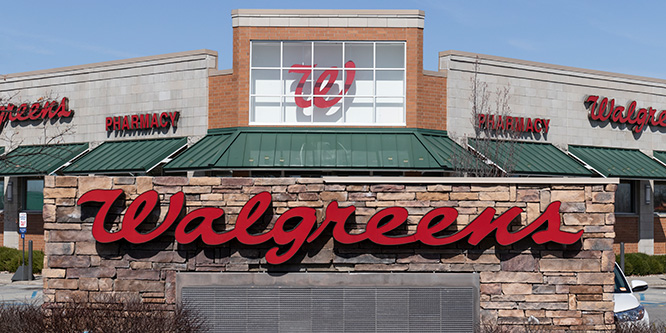
Getty Images/jetcityimage
October 4, 2022
Robo-pharmacies will transform how Walgreens operates its business
Walgreens continues to open automated pharmacies as it moves towards its goal of having 22 of the facilities in operation across the country by 2025.
The drugstore giant, in the past, has said that it expects that robots will fill the majority of prescriptions at 8,500 of its 9,000 or so pharmacies once all the fulfillment centers are operating at capacity. It currently operates eight such facilities.
Robots cut the current workloads of pharmacists in stores by 25 percent, according to a recent Wall Street Journal report. The chain says the machines will free up pharmacists to spend more time interacting with customers in providing consultations, engaging in outreach, administering vaccines and prescribing medications. Pharmacists in stores will fill medications that are time-sensitive as well as those classified as controlled substances.
“This frees up the capacity of our most skilled professionals,” Rina Shah, a group vice president overseeing pharmacy strategy at Walgreens, told the Journal. “We looked at our system and said, ‘Why are we filling prescriptions the way we did in 1995?’”
A shortage of pharmacists has placed added pressure on drugstores that have had to compete for talent. Walgreens, like others, have offered significant signing bonuses to recruit pharmacists. Even with that, about a third of the chain’s pharmacies have had to reduce their hours of operation.
The use of robots in pharmacy operations is well established as pharmacy benefits managers have offered automated mail-order fulfillment for years. Walgreens doesn’t immediately plan to fill mail order prescriptions using its system but expects to do so in the future.
The drugstore giant’s robo-pharmacies have plenty of retail competitors with both CVS and Rite Aid automating the process of filling prescriptions. Smaller pharmacy chains and independents are also looking to automate fulfillment.
Adolf Makia, a pharmacist working at a Walgreens in Texas, told the Journal that the company’s automated fulfillment center in Dallas had cut his workload by 40 percent. He uses that time to connect with customers by calling them to discuss their use of prescribed medications and he also helps connect patients with doctors working at the VillageMD medical office next to the pharmacy.
Walgreens has been rapidly scaling VillageMD clinics inside its stores and expects to have 1,000 in operation by 2027.
Discussion Questions
DISCUSSION QUESTIONS: How will robo-pharmacies change the physical store layouts and other aspects of the drugstore business? Will these facilities be able to negate concerns of pharmacist shortages by 2025?
Poll
BrainTrust
Gary Sankary
Retail Industry Strategy, Esri
Georganne Bender
Principal, KIZER & BENDER Speaking
Ken Morris
Managing Partner Cambridge Retail Advisors
Recent Discussions







Higher labor costs and labor shortages will increase automation in a whole host of areas, especially for routine and repetitive tasks. The filling of basic prescriptions falls into that category. However as Walgreens makes clear, the pharmacist is still essential to interact with customers, check prescriptions, and answer queries. That’s probably a good thing as those areas are where pharmacies add most value and, of late, where service has been a little lacking due to pressure.
It looks like they are starting the process in distribution first so the products arrive ready for store automation. This is a natural progression to automate a very expensive process at store level. I believe the pharmacist is the most expensive role in the store so this equates to mega savings. This might also suggest that the in-store automation might not have a footprint large enough to require major remodels. I would hope that Walgreens is mapping out store changes combining the VillageMD clinics and automation piece.
At the customer level, one benefit of automation in pharmacies is the same as with other types of retailers: more time helping customers. Ideally, this would translate to more time listening to customers, too, so the retailers can get even better at merchandising, category management, and more.
Store layouts may require less drug storage space and pharmacists will have more counter space dedicated to direct interaction with customers. The concept should clearly reduce the pressure on pharmacies to find and hire pharmacists. Giving pharmacists more time to spend providing consultation and engaging in outreach are of utmost importance. We will see pressure on both pharmacies and pharmacists lift gradually but steadily.
I think this makes sense. Counting pills in bottles isn’t a great use of a pharmacist’s time. I suspect that will help with dispensing speed and accuracy more than it will help with service hours. Most of the pharmacies I go to today only have one pharmacist on duty. I would assume that even with automated dispensing, a pharmacist will still have to be present to oversee operations and interact with customers/patients. I hope one benefit of this would be the application of AI to watch for drug interactions and dosing accuracy.
Pharmacists’ crucial role is to interact with customers, so any type of robotic fulfillment that can absorb the transactional piece of the equation is a positive move by Walgreens and other retailers. As we’ve seen in other industries and job functions, automation has allowed associates to spend more of their time solving critical problems and interfacing directly with consumers, which always pays positive dividends.
What is the process of becoming a licensed pharmacist? According to North Central College:
“
…and yet we want these folks to count pills.
As Mr. Makia describes, he uses that time to connect with customers by calling them to discuss their use of prescribed medications, and he also helps connect patients with doctors working at the VillageMD medical office next to the pharmacy. This is what they should be doing, and it fits perfectly with the philosophy of Walgreens and CVS to be the go-to place for healthcare.
I worry that robots are replacing people in key functions and this will ultimately impact our human connections. It is nice to walk into a pharmacy or any store and have someone welcome you that recognizes you as a customer (yes, I know robots can scan you and ID you as well). But current economics are commanding retailers to find efficient and inventive ways to manage their business functions profitably. Automated prescription fulfillment seems like a natural tactic.
Even if automation doesn’t mitigate labor shortages, it might increase pharmacist retention as more mundane tasks are removed from responsibility. A logical application of automation all around.
Because they work in retail locations, pharmacists are more approachable than doctors. And they speak “consumer.” I feel better knowing that there will still be a live pharmacist there to answer questions and check the prescriptions filled by the robots.
There is always a line to speak with a pharmacist whenever I visit a pharmacy, so I am all for technology that frees them up to spend more time with customers. But let’s be real here: Walgreens could decide later on that it needs fewer pharmacists, and that would be a shame.
Robo-pharmacies free up pharmacists’ time and drug store space. Health and beauty goods could move to the back as pharmacists and healthcare gain prominence up front. Pharmacists’ focus is shifting from counting pills to value-added, personalized care to meet consumer demand for wellness.
Why put robots in the store? Chain pharmacies are getting daily deliveries of their drugs from a central location. Why not let robots fill those that are not time-sensitive (like needing refrigeration) and deliver completed scripts to the store? Save a ton on automation for each store.
I moved my prescriptions from my neighborhood Walgreens (despite the easy use of its app) to a nearby “local” pharmacy where they know my name and where the lead pharmacist spent several minutes yesterday discussing a new prescription. Walgreens was in a state of near-chaos earlier this year between staff shortages and COVID-19 testing.
I hope the move to automation at Walgreens triggers more interactions between pharmacists and customers, but I suspect cost savings are the main driver. It will also be crucial that customers can trust the accuracy of the automated process.
Independent community pharmacies have certainly regained their luster — many rediscovered them for the first time during COVID-19 and have become loyal shoppers thereafter.
Hopefully this move will allow pharmacists to practice at the top of their license. The mundane task of pouring, counting, and labeling prescription bottles has long outlived its usefulness. And the physical space devoted to the pharmacy area can be repurposed — which is also long overdue.
I agree wholeheartedly with Rina Shah’s sentiment, “Why are we filling prescriptions the way we did in 1995?”
Yes, yes, yes! Why do you need to be a pharmacist to count pills? What a great solution to solve the problem of labor shortages, while providing for a better opportunity to increase safety and customer service using technology.
Couldn’t agree more, Kai.
Anything that provides the opportunity for health care specialists to spend time with customers is a benefit. So many prescriptions are routine offering the opportunity to be automated. It will be fascinating to get a perspective of how this is received by customers.